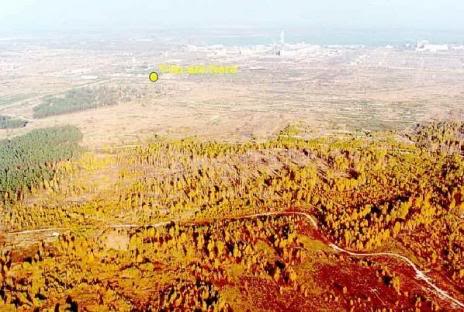When the Chernobyl nuclear reactor in the former Soviet Union, now the Ukraine, melted down and burned April 26, 1986, radiation spread not only into the atmosphere and across the continent, but much of it settled downwind. Near the facility, the radiation killed the pine trees right away over a large area. The rusty-orange color of the dead trees led to the nickname “The Red Forest”.

The Red Forest is among the world’s most radioactive places. If the area had burned in a wildfire, the radiation would be released again into the atmosphere and transported for many miles by the heated air in the convection column. To reduce the hazard, the trees in the Red Forest were cut and then buried, but now officials are concerned about the water table being contaminated. The area bordering the Red Forest, as well as the Red Forest itself, is called the Chernobyl Exclusion Zone (CEZ), and still has a great deal of radiation contamination. The government is looking for ways to prevent it from burning, but they are leaning away from the concept of burying the trees.
Now, surprisingly, an Oregon logger enters the picture. Mike Wiedeman, president of a decades-old family logging business based in Enterprise has been talking with officials in the Ukraine about harvesting the trees so that they can be used as fuel in what might be the world’s largest “closed loop” biomass plant, gasifying wood to create synthesis gas (or “syngas”) in order to generate electricity. Here is an excerpt from an article in the Wallowa County Chieftain:
****
“Wiedeman has grown increasingly interested in the CEZ, and the possibility of working there on a long-term basis, ever since someone in Ukraine’s private sector approached him about becoming involved in a major project that would begin forest-thinning in earnest and convert the logged timber to energy. By mid-October, Mike Wiedeman was aloft over the scene, assessing it from a helicopter.
[…]
After he returned home, his discussions continued with the various players and likely players in the logging and energy project, and early this year the Wiedemans formed a new LLC in Oregon, International Forestry Solutions, through which they hope to perform work in the CEZ.
[…]
In addition to the energy company that will be a key to the overall project, another significant player will be the forestry side’s equipment supplier. Mike Wiedeman thinks this distinction should bring considerable prestige. “There’s tremendous PR value of being the chosen equipment to be used in the toughest environment on the planet,” he said.
And in the CEZ, there’s no such thing as sending equipment out for repair. Any machine that enters the irradiated zone is required to remain there – in theory, forever. This is why the zone is still littered with the hulking remains of all vehicles that were in it when the 1986 crisis unfolded. The zone also lacks a decent network of logging roads.
There’s also the matter of training the people who will work there. While Bryan Wiedeman says he’s looking forward to fine-tuning protocols to help ensure worker safety in the irradiated environment – an appreciable challenge – he adds that he and other loggers he knows can’t seem to help but be drawn to the adventure of it all. “It’s like logging on Mars,” he said.”
